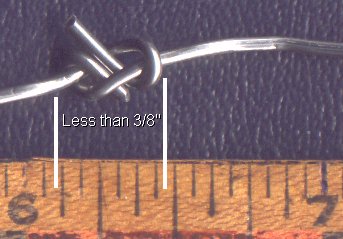Tying a Knot in a Piano String
Tying a Knot in a Piano String
by Art Reblitz, John A. Tuttle, Jon Page (000118
MMDigest)

My book, "Piano Servicing, Tuning and Rebuilding", includes a four-step
procedure for tying a knot in a string, as illustrated by Douglas
Strong
in the "Piano Technicians Journal" issue of November 1972 (and
used with
permission). It is shown on p. 106 of the second edition
of my book.
When I pull up the pitch of a piano, I start in the middle and work
toward the treble, then finish in the bass. If the strings
are in
such bad condition that they will break when pulled up to pitch,
this
condition usually manifests itself in the midrange. My rule
is that if
more than two midrange strings break during a pitch raising, I
replace
them and make no further attempt to raise the pitch of that piano
until
it is restrung.
Tuning thousands of pianos in the 1970s, I rarely had the occasion
to
tie a bass string, because the fragile, rusty treble strings almost
always warned me not to proceed. However, on one occasion,
a perfectly
good looking bass string broke in a little early 1960s Cable grand
made
by Aeolian-American. As the strings still sounded and looked
almost
like new, I thought I'd try the knot-tying technique. The
result of
my first attempt is illustrated on page 111. As the photograph
in the
book shows, this was in an area with very little working room.
After forming a coil in the new leader, placing it on the tuning
pin,
and pulling the string up to pitch, the knot pulled tight -- just
in the
right place -- and the string sounded just like its neighbors.
I later
decided that since I was able to do it on the first try, it was
a tech-
nique worthy of inclusion in the book. As I note in my text,
"this
repair can be very challenging due to the stiffness of the wire;
but
with strength, persistence, and great care taken not to cut your
fingers, it can be done."
Of course, if the string breaks in the sounding portion (between
the
agraffe and the winding) it's difficult to tie a knot that doesn't
end up touching the agraffe as it tightens.
Art Reblitz
Sat, 15 Jan 2000 22:35:46 -0700
[ Jon Page wrote: ]
> The broken wire is in the piano, the splice is the add-on.
> When splicing onto an existing wire, there is only one free end.
> That is on the splice. So the splice has to slip over the
wire.
> If it slipped into the wire loop, how would you get the splice
loop
> around the wire length? See?
>
> First make a loop on the wire. Make the loop on the splice
and
> little larger so the wire loop will pass through. Making
a slight
> bend in the strings at the cross-over helps to align them.
The
> loops need to be opposed.
>
> So the splice loop passes over the wire loop and the splice's
tail
> end is then inserted back into the wire loop and drawn together.
>
> Slide the splice over the wire and insert the tail-end of the
> splice into the wire loop. Draw them together.
>
> Doing is easy, explaining takes a little more effort.
Hi Jon, Attached is the scanned image of my first attempt
at knotting,
using the heaviest gauge piano wire I have, an old worn-out pair
of
needle nose pliers and your instructions. It took me about
seven
minutes, and I did it while sitting here at the computer.
I held the two pieces of wire in my hands, using no vice or other
gripping tools. I did use a heavy set of pliers and a large
vise
to pull the knot tight, but that would (I imagine) normally be
accomplished when the string is brought up to pitch.
Actually, your picture told the whole story. The 'trick' is
making
the loop in the existing string big enough to allow the loop in
the
replacement piece of wire to pass though it and the up-bends so
the
two loops align better.
The last time I tried to knot heavy wire, I spent about 30 minutes
bending and twisting the wire before I gave up in disgust and replaced
the broken bass string with a universal replacement string.
Thanks for the technique,
John A. Tuttle
Sat, 15 Jan 2000 13:33:59 -0500

20 January 2000
|  Gallery
Gallery
 Pictures
Pictures
 knot
knot

